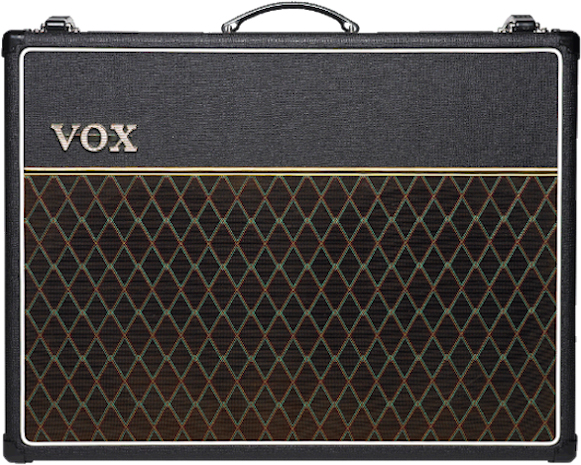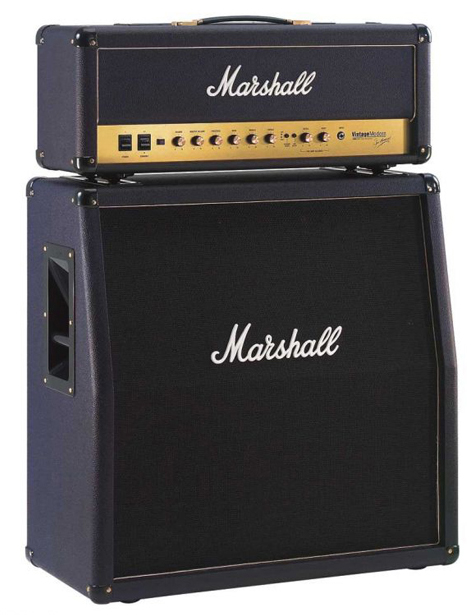 Contemporary Music
Instruction and Mentoring
Selecting an Electric Guitar Amp
Contemporary Music
Instruction and Mentoring
Selecting an Electric Guitar Amp
It is crucial to understand that only half of the
electric guitar "sound" comes from the guitar itself. The
other half comes from the amplifier. You can't just plug
an electric guitar into a PA system or computer or stereo system
and get a good sound. You must have an amplifier made
specifically for electric guitar. A cheap beginner's
electric guitar played through a good amp will sound better than
will a $2,500 Les Paul plugged into a cheap guitar amp or a PA
system.
Traditionally, electric guitars were played through tube
amplifiers. Vacuum tubes create compression and harmonic
distortion that make an electric guitar sound fantastic.
Various kinds of vintage amps use different types of tubes that
have very different sounds from each other. For example,
Fender amps (below left) are based on 6L6GC tubes that at low
gain give a sparkly clean sound, and when overdriven create a
smooth and subtle bluesy harmonic at first, then when turned up
all the way grow to a rich, fat distortion. In the 1960s
up to the mid 1970s nearly all the American rock groups used
various models of Fender amps, including the Beach Boys, BTO,
CCR, Doobie Brothers, Lynyrd Skynyrd, and Eagles. Vox amps
(below center) use EL84 tubes that have a distinctive nasally
crunch sound. In the 1960s through the 1970s most of the
British groups used this amp, including the Beatles, Kinks,
Rolling Stones, Queen, and Dire Straits. Marshall amps
(below right) are based on EL34 tubes that at low gain have a
round tone and when overdriven create a super-compressed and
sustained, awesome rock sound. Think Led Zeppelin,
Journey, Cream, Van Halen, Bon Jovi, AC/DC, and
Jimi Hendrix.
Nearly all the rock music created between 1960 and 1990 was
played through Fender, VOX, and Marshall amps. New release
Fender, VOX, and Marshall tube amps sell for approximately
$1,500-3,000, while used vintage amps from the 1960s-1980s era
are highly sought after collector's items that, if you can find
one in good condition, sell for nearly as much as the new ones.
For
several decades (1980s, 1990s, 2000s), there were no
good-sounding guitar amps at reasonable prices. Tube amps
were -- and still are -- very expensive to make. When
cheap power transistors were invented, the amp manufacturers
introduced inexpensive "solid state" amps that looked like tube
amps on the outside, but sounded lousy. They sold like
hotcakes to naive, aspiring musicians who couldn't afford tube
amps, who naively thought because of the name badge on the front
they were getting a good amp, and couldn't figure out why their
amps sounded so much worse than the famous bands' guitar
sounds! That's because transistors do not respond to
overdrive the same way tubes do. Instead of creating
smooth compression and wonderful sounding even harmonics, they
create ugly, ratty distortion and odd harmonics that sound like
a blown speaker. Most of the amps sold to the general
public from 1980 to 2010 were these terrible solid state amps.
So, for many years, you had to make a choice between high price
with fantastic tone, or low price with horrible tone.
There was nothing inbetween.
Fortunately, thanks to modern technology, you no longer have to
spend big bucks to get a good sound with your electric
guitar. Today, there are modeling amps that use digital
software to mimic the sound and behavior of various classic tube
amps at the push of a button. There
are many choices, but my personal favorite full sized modeling
amp is still the Fender Mustang III V.2 (below). This is
the amp I own, and let me tell you, it is an unbelievable
bargain. With 100 Watts, this amp has plenty of power to
play in a band. But the big selling point is the
variety. It's like having more than a dozen different
kinds of well-known, highly collectable, classic tube amps all
in one, along with a couple of dozen footpedals. Three
additional bonuses are: 1) they weigh half as much as a tube
combo amp; 2) they are far more reliable and rugged than tube
amps; and 3) they have a master volume knob that can turn down
the amp without changing the sound characteristics. Sadly,
these amps have been out of production for several years, but
nice used ones can still be found at reverb.com. If one of
my students buys one, I will be happy to program it with the
presets that I painstakingly created over a two year period that
provide astonishingly good emulations of many favorite vintage
tube amps.

Do digital modeling
amps sound as good as a tube amp? No. Tube amps
sound better... (if they happen to be working today.) BUT,
to my ears, the 45 presets that I have created on the Mustang
III V.2 sound about 80% as good as a real vintage tube amp, and
that's not bad at all. (Compared to old solid state amps,
it's fantastic.) Besides, by the time it's in a band mix
through the PA mains, the difference is not noticeable to the
audience. So for most players, to get the the huge variety
of amp sounds, plus all the pedal effects, with lower weight and
much higher reliability, at an insanely low price, is WELL worth
the tradeoff. Plus, parents love that there's a headphone
jack so the student can play without shaking the house.
For these reasons, I recommend this amp to all my
students. If you are on a budget, it is a far better
choice than a used tube amp that will break down
and be very expensive to fix.
If you decide to purchase a Fender Mustang III V.2, here is some
important additional information:
1. DO NOT buy a Mustang
III amp that does not say "V.2" on the back. If it does
not say V.2 right next to where it says Mustang III, it is a
V.1... stay away. There is a HUGE improvement between V.1
and V.2. (NOTE: if it says nothing about a version number,
it is a V.1.)
2. To get the most out of this amp, the app that backs up your
presets and names them and shows you visually what's going on is
a program called Fender FUSE. Fender no longer supports it
and they don't even offer it for download anymore, but you can
find it for free download with a web search. To run it you
will need either a windows based computer running XP or newer,
or an OLD iMac running OS X El Capitan 10.11.6 or older.
(That's because it is 32 bit software, and no OSX since El
Capitan will run 32 bit apps.) You'll also need a USB A to
USB Mini (NOT Micro) cord to connect the amp to the computer.
3. You don’t need any footswitches for practicing, because
anything the footswitches can do you can also do by pressing the
buttons on the amp with your fingers. However, for stage
use, you should definitely get BOTH of the footswitches for this
amp, because you can’t be walking back to your amp every time
you need to change the sound. Of course, the footswitches
are also more convenient and more fun for practicing, so they
are nice to have, so I recommend that you buy them.
4. The four button footswitch is the most important one.
The model number is MS4. Beware, Fender makes a lot of
four button footswitches that look like the MS4. Do not
buy any other one that looks like it, only buy the MS4 (for
example, the MGT-4 will not work even though it looks the
same). The MS4 sells new for about $80 new if you can find
one, and about half that much for a used one. If you ever
want one I wouldn’t wait too long to grab one, because they are
getting harder to find. The MS4 has a display that shows
what preset you are on. The display can also be used as a
visual tuner. Button 1 mutes the guitar and turns on the
tuner. Button 2 turns on and off the stomp. Button 3
turns on and off the mod. Button 4 turns on and off the
delay.
5. The two button footswitch is the MS2. All Mustang III
amplifiers came with an MS2 footswitch from the factory, but
most of them have been lost over time, so you may need to buy
one. Its two buttons are used to press up or down for the
next higher numbered or lower numbered preset (the amp has 100
presets, and during a gig it’s great to press buttons to go the
next song’s preset).
6. If you buy an MS4 or MS2 new, it will come with a cord.
If you are considering buying a used one, it's nice if you can
find one that has the cord. Otherwise you'll have to make
or buy a cord for it. A lot of the used footswitches sold
online do not include the cord, so pay attention when you buy.
7. The best place to find the Mustang III V.2, MS4, and MS2 is
on Reverb.com, which is an Ebay type market for musical gear.





